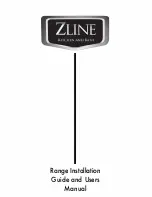
9
BEFORE SETTING SURFACE CONTROLS
CAUTION
Although induction cooking zones do not pro-
duce heat,
they can become hot from contact
with hot cookware
. Burns may occur if a cooking
zone or the surrounding area is touched before it
has cooled to a safe temperature.
NOTE
Be sure to read detailed instructions for induction
cooktop cleaning in the “Care and Cleaning” sec-
tion and “Before You Call” checklist section of this
Use and Care Manual.
Sounds
The magnetic fi eld over the induction cooking zone
may cause cookware to vibrate, creating a buzzing
or humming noise. These sounds are not unusual,
especially at high settings.
Cookware that is not
perfectly fl at on the
bottom may vibrate
slightly against the
cooktop.
A loose handle may
vibrate in its socket.
Multi-material cookware
may allow small vibra-
tions in its structure.
Figure 1: Induction sounds
Sounds are less likely to occur with heavier, higher
quality cookware.
An induction cooktop may also produce faint click-
ing sounds from the electronic switches that main-
tain the desired cooking temperature. You may
also hear a fan that cools the electronics inside the
cooktop.
How does induction work?
Most cooking uses radiant heat that must pass
through the cookware to get food hot. Induction is
a process that induces heat with an energy reac-
tion. When each cooking zone is turned on, power
goes to a coil under the cooktop. The powered
coil creates an electromagnetic fi eld. The electro-
magnetic fi eld reacts with compatible materials in
cookware, creating heat in the cookware itself. The
power level controls the heating level, delivering
precise results.
Induction Benefi ts
Because heat starts in the cookware instead of the
cooktop, induction off ers several advantages.
Cleaner cooking:
Because induction works by
heating the cookware and not the cooktop, spills
don’t cook or stick to the surface.
Cooler Cooktop:
An induction cooktop will be
cooler when you remove cookware than a con-
ventional cooktop would be. The only radiant heat
produced in induction is from the cookware itself,
so the kitchen stays cooler, too.
Fast Heating:
Cookware will heat up faster than on
a conventional electric cooktop. Pay close atten-
tion to avoid scorching food when starting to cook.
You may need to use a lower setting for cooking
food than you are used to.
Precise Control:
The heat going into the cookware
will change immediately when you change the set-
ting of the cooking zone.
Even Heating:
Cookware will typically heat more
evenly on an induction cooktop, so you are less
likely to have hot or cool spots in the cookware.
Energy Effi
ciency:
Because induction creates heat
directly in the pan, it uses less electricity than a
conventional cooktop.
Before Using Your Cooktop
Before using your cooktop for the fi rst time, apply
a ceramic cooktop cleaning cream (available in
most hardware, grocery, and department stores)
to the ceramic surface. Clean and buff with a clean
paper towel. Cooktop cleaning creams leave a
protective fi nish on the glass that will make clean-
ing easier when the cooktop is soiled from cooking
and help prevent scratches and abrasions.










































